2013 Yamaha Nytro Boosted
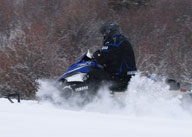
Adding 45 horses to the base flatland Nytro seems so un-Yamaha
Yamaha can seem a bit strange at times. We’ve never seen a snowmobile company as relentless in product testing as Yamaha. Sometimes to the detriment of sled sales. That contrasts to Arctic Cat, which seems to get product to the snow faster than about any other sled maker. And, sometimes to the detriment of future sales.
If any of you recall the early life of the Arctic Cat Firecat F7, you must recall its early release problems, which the model overcame as it went on to be one the most loved Cats of recent times. A sled manufacturer has to balance its degree and intensity of testing with its desire to get sales as quickly as it can.
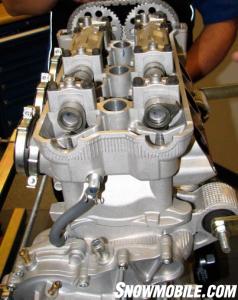 Yamaha’s Genesis engine is watch-like in precision quality.
Yamaha’s Genesis engine is watch-like in precision quality.
So, when it comes to building sleds that are the fastest and most powerful, it’s little wonder that Arctic Cat has embraced boosting output via turbocharging and that Yamaha has resisted that urge – until now.
Arctic Cat amped up its stock one-liter four-stroke twin to 177 horsepower by adding an intercooled turbocharger. Doing that allowed Arctic Cat to retain most powerful production sled bragging rights. But using turbochargers to gain power has been a standard procedure for Arctic Cat since the T660 model, which Cat engineers used to give the brand a clean, yet fast trail sled.
Yamaha, however, or at least a handful of folks within the company and vendors who supply Yamaha, have pushed for adding power, especially to its mountain sleds, which compete with a distinct weight disadvantage. The idea for boosting power for powder sleds hinges on power-to-weight. If you can’t drop weight to compete with a Polaris RMK, maybe adding horsepower via a turbocharger can help keep Yamaha riders brand loyal.
That’s why you saw a special Yamaha-promoted turbo aftermarket option for the Nytro MTX. But, part of the deal was that all kits had to be used above 6,000 feet for the warranty to be in effect. That didn’t make the flatland Yamaha rider happy at all.
Still, Yamaha looked at the success it had with the mountain turbo kit and gambled again. This September the company announced its optional “Trail Supercharger kit,” designed for riders playing below 6,000 feet elevation.
The company claimed that its kit was designed to work seamlessly with the stock Yamaha fuel injection system and that it would retain the stock exhaust. The latter was important as a number of flatland states ticket loud or excessive exhausts.
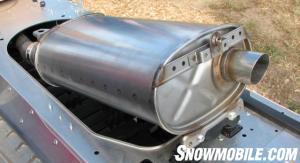 Stock exhaust keeps the sled quiet and trail legal.
Stock exhaust keeps the sled quiet and trail legal.
The kit results from a partnership with Yamaha and Mountain Performance Inc., which also worked on the mountain sled kits. This time MPI offers a supercharger instead of a turbocharger.
Yamaha settled on the supercharger, although a turbocharger effectively achieves a similar result, just going about it differently. The turbo charger builds power off the engine’s exhaust, while the supercharger system drives directly off the engine via a belt.
Depending on how you look at the world, the turbocharger might be deemed more efficient as it uses “waste” energy from the exhaust. The supercharger takes power directly from the engine, but delivers it instantly. The turbo may lag a bit until the engine’s exhaust builds to high revs.
The reality is that both systems force air into the engine via compression, allowing more air and fuel/air mixture to get stuffed into the combustion chambers. In general these devices are set relatively modest for boost pressure, measured in pounds per square inch (psi). Yamaha’s supercharger is said to be about 6 psi on premium pump gas for about 180 horsepower. But, since this is a kit and not a production run sled, the Yamaha wont’ keep Arctic Cat from keeping its claim for most horsepower. And if it ever had come down to that, we’d bet that Arctic Cat would have tweaked a boost psi enough to get enough extra ponies to surpass the Yamaha claim.
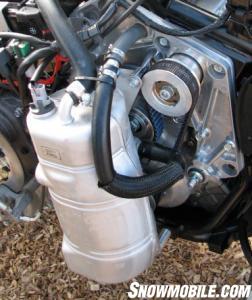 The belt-drive MPI supercharger fits neatly, meaning that the hood and side panels remain stock in appearance.
The belt-drive MPI supercharger fits neatly, meaning that the hood and side panels remain stock in appearance.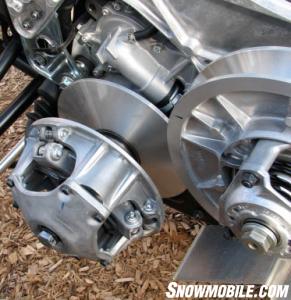 The only tip off to the power boost will come in little areas, like the added tunnel-mounted auxiliary cooler, some clutch weight and calibration changes to handle the added 45 hp.
The only tip off to the power boost will come in little areas, like the added tunnel-mounted auxiliary cooler, some clutch weight and calibration changes to handle the added 45 hp. One thing we will say about the Yamaha Nytro four-stroke triple, we have to believe that it could readily handle a lot more boost. Afterrmarket companies have gone to 11 psi and claim 220 horsepower. But that creates other needs that the stock Yamaha accessory supercharger kit won’t. With big boost comes the need to totally revise the drivetrain. If you check the Yamaha flatland boost kit you see that minimal updates are needed and the kit fits smartly under the hood. The end result is a healthy 45 horsepower gain that will give your 2008 to 2013 Nytro, Nytro RTX or Nytro XTX, including the XTX 1.75, a very nice power bump while keeping your sled looking subtly stock. All the better to mess with an Arctic Cat XF1100 Turbo Sno Pro rider.
In head to head running we’d imagine the Arctic Cat rider won’t whimper much as the latest 2012-2013 Arctic Cat’s will handle exceptionally well and likely won’t give up much straightaway speed despite the few extra horses that the Yamaha may get from its supercharged persona.
We do find Yamaha’s resistance to boosting production sleds a little mystifying as the company fielded a boosted street bike in the 1980s and has a significant history working on turbocharged Formula One engines. And let’s not forget the fact that Yamaha engineering was directly responsible for the original Ford Taurus SHO V8.
Arctic Cat hasn’t been the only sled maker to offer production turbo sleds, but it has been the most visible. Polaris managed to get 140 horsepower from its 750cc four-stroke engine. Cat got about that from the 660cc T660 engine. And its current one-liter four-stroke has to be one of the most quietly disconcerting powerplants we’ve ever ridden. When used in the touring models, the two-up Cats are incredibly docile. But there is always that edge you can call on to rip off a quick mile. And for riding in the high plains, the turbocharged Cats go from flats to mountain passes with nary a care. Arctic Cat has done a great job with its boosted engines, using its experience to great effect.
We hope that Yamaha will follow suit, as the base Nytro triple can no doubt handle more power. These Yamaha triples and quads are engineered like fine watches. Indeed, whenever we see a modern Yamaha Genesis laid out exposing its innards, we are in awe, or at least feel like what we imagine a fine watchmaker must feel like when he looks inside a Rolex or Omega. These engines are fine-tuned instruments that can handle the 45 hp bump. And, while Yamaha may be reluctant to offer boosted engines for production, the kit and its pieces fit like you’d expect a Yamaha kit to fit. There are no modifications to the hood or side panels and the wiring fits stock-style connectors. But, then you expect that.
Related Reading
Yamaha Offering Supercharger Kit for FX Nytro
2013 Yamaha FX Nytro Review
2013 Yamaha Nytro MTX 162 Turbo Review – Video



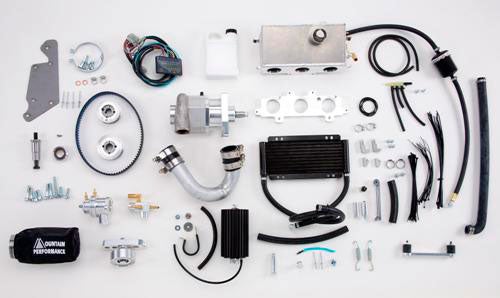
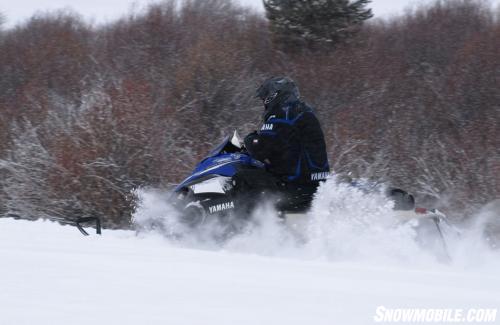





 Your Privacy Choices
Your Privacy Choices